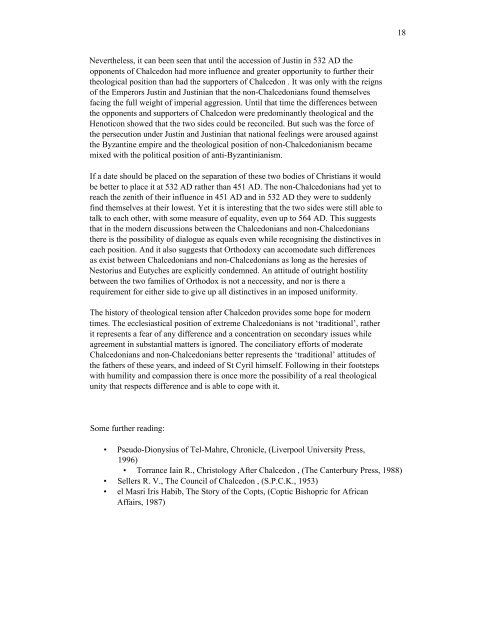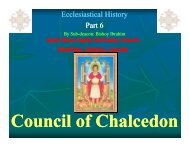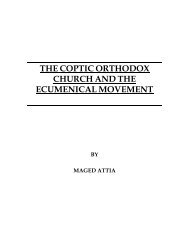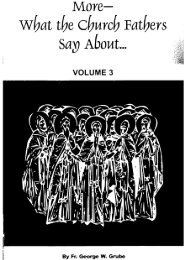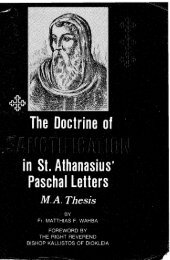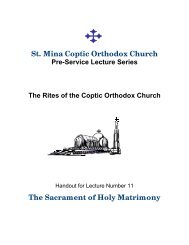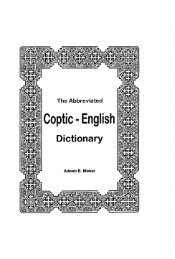Coptic interpretations of the Fourth Ecumenical Council - Saint Mina ...
Coptic interpretations of the Fourth Ecumenical Council - Saint Mina ...
Coptic interpretations of the Fourth Ecumenical Council - Saint Mina ...
Create successful ePaper yourself
Turn your PDF publications into a flip-book with our unique Google optimized e-Paper software.
Never<strong>the</strong>less, it can been seen that until <strong>the</strong> accession <strong>of</strong> Justin in 532 AD <strong>the</strong><br />
opponents <strong>of</strong> Chalcedon had more influence and greater opportunity to fur<strong>the</strong>r <strong>the</strong>ir<br />
<strong>the</strong>ological position than had <strong>the</strong> supporters <strong>of</strong> Chalcedon . It was only with <strong>the</strong> reigns<br />
<strong>of</strong> <strong>the</strong> Emperors Justin and Justinian that <strong>the</strong> non-Chalcedonians found <strong>the</strong>mselves<br />
facing <strong>the</strong> full weight <strong>of</strong> imperial aggression. Until that time <strong>the</strong> differences between<br />
<strong>the</strong> opponents and supporters <strong>of</strong> Chalcedon were predominantly <strong>the</strong>ological and <strong>the</strong><br />
Henoticon showed that <strong>the</strong> two sides could be reconciled. But such was <strong>the</strong> force <strong>of</strong><br />
<strong>the</strong> persecution under Justin and Justinian that national feelings were aroused against<br />
<strong>the</strong> Byzantine empire and <strong>the</strong> <strong>the</strong>ological position <strong>of</strong> non-Chalcedonianism became<br />
mixed with <strong>the</strong> political position <strong>of</strong> anti-Byzantinianism.<br />
If a date should be placed on <strong>the</strong> separation <strong>of</strong> <strong>the</strong>se two bodies <strong>of</strong> Christians it would<br />
be better to place it at 532 AD ra<strong>the</strong>r than 451 AD. The non-Chalcedonians had yet to<br />
reach <strong>the</strong> zenith <strong>of</strong> <strong>the</strong>ir influence in 451 AD and in 532 AD <strong>the</strong>y were to suddenly<br />
find <strong>the</strong>mselves at <strong>the</strong>ir lowest. Yet it is interesting that <strong>the</strong> two sides were still able to<br />
talk to each o<strong>the</strong>r, with some measure <strong>of</strong> equality, even up to 564 AD. This suggests<br />
that in <strong>the</strong> modern discussions between <strong>the</strong> Chalcedonians and non-Chalcedonians<br />
<strong>the</strong>re is <strong>the</strong> possibility <strong>of</strong> dialogue as equals even while recognising <strong>the</strong> distinctives in<br />
each position. And it also suggests that Orthodoxy can accomodate such differences<br />
as exist between Chalcedonians and non-Chalcedonians as long as <strong>the</strong> heresies <strong>of</strong><br />
Nestorius and Eutyches are explicitly condemned. An attitude <strong>of</strong> outright hostility<br />
between <strong>the</strong> two families <strong>of</strong> Orthodox is not a neccessity, and nor is <strong>the</strong>re a<br />
requirement for ei<strong>the</strong>r side to give up all distinctives in an imposed uniformity.<br />
The history <strong>of</strong> <strong>the</strong>ological tension after Chalcedon provides some hope for modern<br />
times. The ecclesiastical position <strong>of</strong> extreme Chalcedonians is not ‘traditional’, ra<strong>the</strong>r<br />
it represents a fear <strong>of</strong> any difference and a concentration on secondary issues while<br />
agreement in substantial matters is ignored. The conciliatory efforts <strong>of</strong> moderate<br />
Chalcedonians and non-Chalcedonians better represents <strong>the</strong> ‘traditional’ attitudes <strong>of</strong><br />
<strong>the</strong> fa<strong>the</strong>rs <strong>of</strong> <strong>the</strong>se years, and indeed <strong>of</strong> St Cyril himself. Following in <strong>the</strong>ir footsteps<br />
with humility and compassion <strong>the</strong>re is once more <strong>the</strong> possibility <strong>of</strong> a real <strong>the</strong>ological<br />
unity that respects difference and is able to cope with it.<br />
Some fur<strong>the</strong>r reading:<br />
• Pseudo-Dionysius <strong>of</strong> Tel-Mahre, Chronicle, (Liverpool University Press,<br />
1996)<br />
• Torrance Iain R., Christology After Chalcedon , (The Canterbury Press, 1988)<br />
• Sellers R. V., The <strong>Council</strong> <strong>of</strong> Chalcedon , (S.P.C.K., 1953)<br />
• el Masri Iris Habib, The Story <strong>of</strong> <strong>the</strong> Copts, (<strong>Coptic</strong> Bishopric for African<br />
Affairs, 1987)<br />
18


